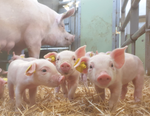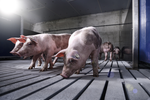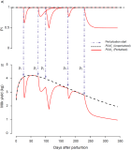Latest recommendations

| Id | Title | Authors | Abstract | Picture▲ | Thematic fields | Recommender | Reviewers | Submission date | |
|---|---|---|---|---|---|---|---|---|---|
05 Jul 2022

Impact of pre-breeding feeding practices on rabbit mammary gland development at mid-pregnancy.Cathy Hue-Beauvais, Karine Bebin, Raphael Robert, Delphine Gardan-Salmon, Mickael Maupin, Nicolas Brun, Etienne Aujean, Florence Jaffrezic, Steve Simon, Madia Charlier, Fabienne Le Provost https://doi.org/10.1101/2022.01.17.476562Managing the feeding of rabbits to improve metabolic efficiencyRecommended by Giuseppe Conte based on reviews by Marion Boutinaud, Davi Savietto and 1 anonymous reviewerA correct execution of feeding plan for growing rabbit decreases the possibility of post-weaning digestive disorders, thus enhancing the feed efficiency in the animals. However, a limitation of feed daily quantity is required between 10 weeks of age and the first artificial insemination. This limitation causes energy deficiency with a consequent reduction in fertility. Beauvais et al. (2022) studied the impact of feed restriction strategies in female rabbits. Four feed restriction strategies were applied in two distinct periods (post-weaning and puberty) and evaluated by different physiological parameters (growth rate, metabolic profiles, reproductive parameters and mammary gland development). In the first part of the paper, the authors evaluated the association between weight slopes and feeding strategies in the late post-weaning and peripartum period in the four groups. As revealed by the authors, a significant difference was observed during the late post-weaning period, which remained significant between the pubertal and fattening phases. Probably these differences are related to the restriction feeding pattern. The results indicated that restrictive feeding changes in the first step of post-weaning period is associated with a significant difference in body weight. This difference occurs from the third week of diet, highlighting the high sensitivity of growing rabbit to nutrition during the post-weaning period. In the second part of the paper, the authors evaluated the expression of genes involved in the lipid metabolism. During the mid-pregnancy, was revealed a significant higher expression of lipogenic genes, which may be considered as useful markers for the mammary epithelial development in less restrictive strategies during early life period. The results proposed by Beauvais et al. (2022) enlighten the important role played by the feeding conditions of young female rabbits in the early life rearing. In particular, this activity provides specific recommendations for optimizing lactation and thus preventing neonatal mortality of the offspring. Moreover, the authors provide indications about the effect of feeding strategies on the mammary development and gene expression with absolute consequences on the development of offspring. Mammary lipid metabolism affects the milk profile and therefore the growth performance of the young animals. Reference
Hue-Beauvais C, Bebin K, Robert R, Gardan-Salmon D, Maupin M, Brun N, Aujean E, Jaffrezic F, Simon S, Charlier M, Le Provost F (2022). Impact of pre-breeding feeding practices on rabbit mammary gland development at mid-pregnancy. biorXiv, 2022.01.17.476562, ver. 3 peer-reviewed and recommended by Peer Community in Animal Science. https://doi.org/10.1101/2022.01.17.476562 | Impact of pre-breeding feeding practices on rabbit mammary gland development at mid-pregnancy. | Cathy Hue-Beauvais, Karine Bebin, Raphael Robert, Delphine Gardan-Salmon, Mickael Maupin, Nicolas Brun, Etienne Aujean, Florence Jaffrezic, Steve Simon, Madia Charlier, Fabienne Le Provost | <p>Optimizing rabbit does preparation during early life to improve reproductive potential is a major challenge for breeders. Does selected for reproduction have specific nutritional needs, which may not be supplied with the common practice of feed... |  | Animal nutrition modelling | Giuseppe Conte | 2022-01-19 14:44:30 | View | |
10 Aug 2022

Decreasing the level of hemicelluloses in sow's lactation diet affects the milk composition and post-weaning performance of low birthweight piglets.Francesco Palumbo, Giuseppe Bee, Paolo Trevisi, Marion Girard https://doi.org/10.31220/agriRxiv.2022.00116Varying the hemicellulose content in the diet of lactating sows highlights the importance of early-life interventions for improving health and performance of small piglets during the post-weaning periodRecommended by Florence Gondret based on reviews by Hélène Quesnel and Myriam GrundyOne of the key questions in pig industry nowadays is how health and performance of piglets can be improved by sow nutrition and milk composition. The levels of dietary fibers in sow’s gestation diet have positive effects observed on the litters. However, the composition of dietary fibers and the organization of polysaccharides within the cell wall in the different plants determine their physicochemical properties and, thereby, their behaviour in the gut of the sows and the subsequent physiological response of the animals. Hemicelluloses are polysaccharides constituents of the cell walls of plants, which are fermented in the gut to produce volatile fatty acids (VFA). These VFA can serve as energy source for milk synthesis and can thereby influence the development of suckling piglets. Palumbo and colleagues (1) proposed an original experimental design to compare diets with similar fiber contents but different hemicellulose levels, thanks to varying the sources of fibers used in the dietary formulations. Effects were studied on performance and health of lactating sows and their piglets during suckling period and until post-weaning. The dietary treatments had no effect on the total number of piglets weaned and, consequently, on litter weight at weaning. Milk yield was not influenced by the dietary treatments, but milk composition (lactose content, copper and threonine proportions) was affected by the level of hemicellulose in the maternal diets. With a decreasing hemicellulose level in sow diet, milk lactose content linearly decreased, whereas the copper and threonine contents linearly increased. There was no effect on piglet performance during the lactation period. During the second week of post-weaning, a quadratic increase in the incidence of diarrhoea and the number of days with diarrhoea for suckling piglets was observed with decreasing hemicellulose level in diet. Interestingly, the observed effects were partly different for piglets born with a low body weight. Indeed, there was a linear decrease in the incidence of diarrhoea and days with diarrhoea with decreased hemicellulose level in the maternal diet for those piglets, together with increased growth performance from birth to two weeks post-weaning. The authors postulated that the improved growth performance and the lower incidence of diarrhoea observed in small piglets during post-weaning period may be related to the increased abundance of threonine and copper and increased concentration of total VFA in milk of sows fed a diet with reduced hemicellulose levels. This study confirms the importance of early-life interventions to improve the post-weaning development and health of this sub-population of piglets. Reference (1) Palumbo F, Bee G, Trevisi P, and Girard M. (2022). Decreasing the level of hemicelluloses in sow's lactation diet affects the milk composition and post-weaning performance of low birthweight piglets. agriRxiv 2022.00116, ver 4 (R3), peer-reviewed and recommended by PCI Animal Science. https://doi.org/10.31220/agriRxiv.2022.00116 | Decreasing the level of hemicelluloses in sow's lactation diet affects the milk composition and post-weaning performance of low birthweight piglets. | Francesco Palumbo, Giuseppe Bee, Paolo Trevisi, Marion Girard | <p>Hemicelluloses (HC) are polysaccharides constituents of the cell walls of plants. They are fermented in the gut to produce volatile fatty acids (VFA). The present study investigated the effects of decreasing HC level in sow's lactation diet on ... |  | Pig nutrition | Florence Gondret | 2022-01-21 12:00:22 | View | |
16 Apr 2021

Modelling the impact of the macroalgae Asparagopsis taxiformis on rumen microbial fermentation and methane productionRafael Muñoz-Tamayo , Juana C. Chagas, Mohammad Ramin, Sophie J. Krizsan https://doi.org/10.1101/2020.11.09.374330Understanding the mechanisms behind natural bioactive compounds that can potentially reduce methane production in anaerobic conditions. A case study of Asparagopsis taxiformisRecommended by Luis Tedeschi based on reviews by Alberto Atzori, Henk van Lingen and 2 anonymous reviewersNaturally occurring compounds that can reduce methane production in anaerobic conditions have been studied for quite some time as feasible approaches to mitigate methane production in ruminant animals, especially those of commercial importance. Asparagopsis taxiformis (red algae) and Dictyota bartayresii (brown algae) are effective inhibitors of methane synthesis under in vitro anaerobic fermentation systems (Machado et al., 2014) likely because of their high concentration of secondary metabolites that are toxic to the typical rumen microbiota, including protozoa. In addition to phytoplankton (Palmer and Reason, 2009), Asparagopsis contains a high concentration of haloform compounds (e.g., bromoform, chloroform) while Dictyota has a high concentration of isoprenoid terpenes. Despite the economic and biological impact of diverse phytochemicals on reducing methane production in ruminant animals (Tedeschi et al., 2021), haloform compounds’ environmental impact and safety, in particular, are still unclear. In the present study, Munõz-Tamayo and collaborators (2021) listed relevant literature about the impact of A. taxiformis on ruminal methane production. Concurrent to the understanding of mechanisms and biology behind the reduction of ruminal methane, mathematical models can lead the way to enhance the effectiveness of feeding A. taxiformis under commercial applications. Thus, in the present study, Munõz-Tamayo and collaborators (2021) sought to develop a mathematical model to understand the rumen fermentation changes in vitro experimentation containing extract of A. taxiformis by adapting a previously documented model by Muñoz-Tamayo et al. (2016). Modeling development, calibration, and evaluation steps should be independent of each other, requiring complete, distinct, and separate databases (Tedeschi, 2006). However, in rare circumstances where such requirements cannot be met because data availability is scarce, the cross-validation technique, when possible, should be considered to assess data dispersion’s effects on model adequacy. In other situations, clear reasoning for failing to do so must be addressed in the paper. In the present paper, Munõz-Tamayo and collaborators (2021) explained the limitations in their modeling efforts were primarily due to the lack of ideal data: “experiments with simultaneous dynamic data of bromoform, volatile fatty acids, hydrogen, and methane.” Regardless of the availability of ideal data, improvements in the conceptual model are warranted to include amino acids and branched-chain fatty acids fermentation dynamics in the rumen and the fluctuations in ruminal pH. References Machado L, Magnusson M, Paul NA, Nys R de, Tomkins N (2014) Effects of Marine and Freshwater Macroalgae on In Vitro Total Gas and Methane Production. PLOS ONE, 9, e85289. https://doi.org/10.1371/journal.pone.0085289 Muñoz-Tamayo R, Chagas JC, Ramin M, Krizsan SJ (2021) Modelling the impact of the macroalgae Asparagopsis taxiformis on rumen microbial fermentation and methane production. bioRxiv, 2020.11.09.374330, ver. 4 peer-reviewed and recommended by PCI Animal Science. https://doi.org/10.1101/2020.11.09.374330 Muñoz-Tamayo R, Giger-Reverdin S, Sauvant D (2016) Mechanistic modelling of in vitro fermentation and methane production by rumen microbiota. Animal Feed Science and Technology, 220, 1–21. https://doi.org/10.1016/j.anifeedsci.2016.07.005 Palmer CJ, Reason CJ (2009) Relationships of surface bromoform concentrations with mixed layer depth and salinity in the tropical oceans. Global Biogeochemical Cycles, 23. https://doi.org/10.1029/2008GB003338 Tedeschi LO (2006) Assessment of the adequacy of mathematical models. Agricultural Systems, 89, 225–247. https://doi.org/10.1016/j.agsy.2005.11.004 Tedeschi LO, Muir JP, Naumann HD, Norris AB, Ramírez-Restrepo CA, Mertens-Talcott SU (2021) Nutritional Aspects of Ecologically Relevant Phytochemicals in Ruminant Production. Frontiers in Veterinary Science, 8. https://doi.org/10.3389/fvets.2021.628445 | Modelling the impact of the macroalgae Asparagopsis taxiformis on rumen microbial fermentation and methane production | Rafael Muñoz-Tamayo , Juana C. Chagas, Mohammad Ramin, Sophie J. Krizsan | <p>Background: The red macroalgae Asparagopsis taxiformis is a potent natural supplement for reducing methane production from cattle. A. taxiformis contains several anti-methanogenic compounds including bromoform that inhibits directly methanogene... |  | Agricultural sustainability, Animal nutrition modelling, Emissions , Mathematical modelling, Microbial fermentation, Rumen microbiology, Rumen microbiome | Luis Tedeschi | 2020-11-17 06:28:29 | View | |
20 Dec 2021

Quantifying growth perturbations over the fattening period in swine via mathematical modellingManuel Revilla, Guillaume Lenoir, Loïc Flatres-Grall, Rafael Muñoz-Tamayo, Nicolas C Friggens https://doi.org/10.1101/2020.10.22.349985An innovative modelling approach to enhance the quality of the quantification of pig resilience during the entire fattening period: Towards an individual pig resilience indexRecommended by Mohammed Gagaoua based on reviews by Arata Hidano, Ludovic Brossard and 2 anonymous reviewers based on reviews by Arata Hidano, Ludovic Brossard and 2 anonymous reviewers
The identification of reliable estimates of growth potential and resilience over the fattening period in large populations is a challenge in actual swine breeding conditions. To overcome this drawback, the study by Revilla et al. 2021 in the frame of precision livestock farming aimed to propose an innovative modelling approach, in addition to previous studies from the same group (Revilla et al. 2019), to enhance the quality of the quantification of pig resilience during the entire fattening period. The authors developed a model that quantifies an “individual pig resilience indicator” based on longitudinal data, for instance body weight, recorded routinely by a commercially available automatic feeding system. Revilla and co-workers considered in their study two mainly commercialised pure pig breeds these being Piétrain including Piétrain Français NN Axiom line (Pie NN) free from halothane-sensitivity (ryanodine receptor gene, RYR1) and Piétrain Français Axiom line positive to this gene and Duroc. Therefore, the authors investigated the potential of improving resilience of swine livestock through inclusion for the first time of an “individual pig resilience indicator” in breeding objectives. A database of 13 093 boars (approximately 11.1 million of weightings) belonging to Pie (n= 5 841), Pie NN (n = 5 032) and Duroc (n= 2 220) finished under ad libitum feeding, high sanitary level and controlled temperature was used to develop robust models. The authors checked the three datasets (for each pig breed) independently to explore the variation and gaps (a data pre-treatment procedure) to ensure high quality data for the modelling approach. Then, they applied the Gompertz model and linear interpolation on body weight data to quantify individual deviations from the expected production, allowing the creation of the ABC index. For the modelling, the authors applied a two-step mathematical model approach by first establishing a theoretical growth curve of each animal, while the second step aimed to build the actual perturbed growth curve. The heritability of the index ranged from 0.03 to 0.04, with similar heritability between Piétrain and Duroc breeds. Moreover, moderate genetic relationships were computed between the proposed index and important phenotypic traits in swine production likely BF100: backfat thickness at 100kg; LD100: longissimus dorsi thickness at 100kg; ADG: average daily gain during control and FCR: feed conversion ratio. Developing models able to capture perturbations during the fattening period is a challenge in swine breeding industry. The model and methodology proposed by the authors in this innovative work (although preliminary and with low heritabilities) would help overcome such limit and facilitate a real implementation at large scale in pig breeding system. The modelling approach further offers an opportunity to develop a selection criterion to improve resilience in swine breeding conditions. To explore the full potential of this modelling approach, a larger database and other factors such as breed, behaviour and feeding behaviour of the animals, rearing practices, management and environment conditions, age… etc. are worthy to consider. In the future, more in depth measurements of behaviour that can be computed for example using computer vision should be desirable to increase the robustness of the proposed model. References Revilla, M., Friggens, N.C., Broudiscou, L.P., Lemonnier, G., Blanc, F., Ravon, L., Mercat, M.J., Billon, Y., Rogel-Gaillard, C., Le Floch, N. and Estellé, J. (2019). Towards the quantitative characterisation of piglets’ robustness to weaning: a modelling approach. Animal, 13(11), 2536-2546. https://doi.org/10.1017/S1751731119000843 Revilla M, Lenoir G, Flatres-Grall L, Muñoz-Tamayo R, Friggens NC (2021). Quantifying growth perturbations over the fattening period in swine via mathematical modelling. bioRxiv, 2020.10.22.349985, ver. 5 peer-reviewed and recommended by Peer Community in Animal Science. https://doi.org/10.1101/2020.10.22.349985 | Quantifying growth perturbations over the fattening period in swine via mathematical modelling | Manuel Revilla, Guillaume Lenoir, Loïc Flatres-Grall, Rafael Muñoz-Tamayo, Nicolas C Friggens | <p>Background: Resilience can be defined as the capacity of animals to cope with short-term perturbations in their environment and return rapidly to their pre-challenge status. In a perspective of precision livestock farming, it is key to create i... |  | Animal genetics, Animal health, Farming systems, Mathematical modelling, Precision livestock farming | Mohammed Gagaoua | 2020-10-26 11:47:08 | View | |
06 Sep 2019

Lactation curve model with explicit representation of perturbations as a phenotyping tool for dairy livestock precision farming.Ben Abdelkrim Ahmed, Puillet Laurence, Gomes Pierre, Martin Olivier https://doi.org/10.1101/661249Developing smart fitting algorithms to identify random perturbations in time-series dataRecommended by Luis Tedeschi based on reviews by Alberto Atzori, Jennifer Spencer and 1 anonymous reviewerThe ability to adequately characterize the lactation curve of livestock is important not only to ensure proper nutrition of the lactating animal but, among many other benefits, it can assist in diagnosing the incidence of diseases, predicting the quantity of milk production, and comparing animals within the herd for managerial strategies such as culling. Eventually, such smart fitting algorithms can lead to improved genetic selection of more productive animals after genetic-unrelated noises are removed from the data, systematically. References [1] Johansson, I. (1961). Genetic Aspects of Dairy Cattle Breeding. University of Illinois Press, Urbana, IL. [2] Nelder, J. A. (1966). Inverse polynomials, a useful group of multi-factor response functions. Biometrics. 22 (1):128-141. doi: 10.2307/2528220 | Lactation curve model with explicit representation of perturbations as a phenotyping tool for dairy livestock precision farming. | Ben Abdelkrim Ahmed, Puillet Laurence, Gomes Pierre, Martin Olivier | <p>Background Understanding the effects of environment on livestock provides valuable information on how farm animals express their production potential, and on their welfare. Ruminants are often confronted with perturbations that affect their per... |  | Lactation biology , Mathematical modelling, Precision livestock farming | Luis Tedeschi | 2019-06-07 09:38:26 | View |
MANAGING BOARD
Karol B Barragán-Fonseca
Mohammed Gagaoua
Rachel Gervais
Florence Gondret
Francois Meurens
Rafael Muñoz-Tamayo
Anna Olsson
Seyed Abbas Rafat
Yuliaxis Ramayo-Caldas









